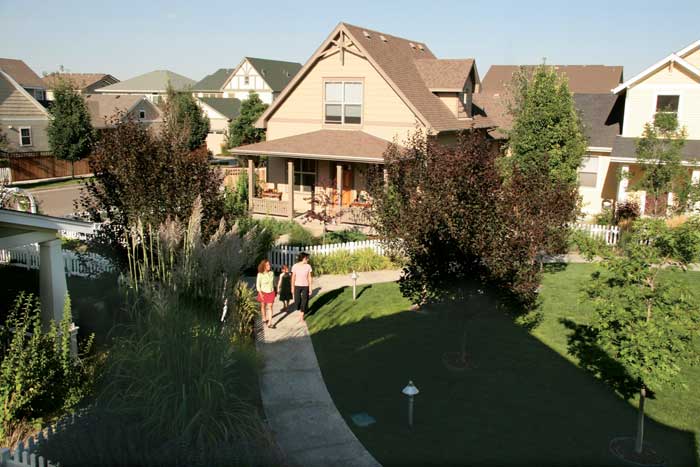Ten years ago and counting, a few brave souls chose to move to the largest new urbanism community in the United States. At the time, it consisted of promises and visions laid out in the Green Book and thousands of undeveloped brownfield acres on a discarded urban airport. It took courage to buy a home in this untested site. So what brought Stapleton pioneers here? Their desire to invest in a real community—one that was as much, if not more, about the neighborhood than the options of the home interior.
Those early Stapleton pioneers were followed by annual migrations from surrounding neighborhoods, other Denver-metro cities, and even immigrants from faraway places such as Texas, California and New York. Today, Stapleton is no longer an untested experiment. With over 5,400 homes, 1,000 apartments, 17,000 residents, 10 schools, 800 acres of parks and wetlands, nearly 400,000 sq. ft. of office space, 1.2 million sq. ft. of industrial/office flex space, 2.1 million sq. ft. of retail space, and a host of awards, it is now one of the most successful in-fill urban projects in the country.


Above, the same house is shown being built in 2002 and now eight years later in its fully built-out neighborhood.
But its true success will not be measured in simply the number of houses sold, the value of the property, or the sheer size of the finished development (4,700 acres). Rather, Stapleton will make its mark in the annals of city life if it can truly implement the tenets of New Urbanism.
At its most basic definition, New Urbanism is old urbanism revived, using modern zoning and master planning to create diverse, socially and economically vibrant neighborhoods that are interconnected to the surrounding city. In 1999, the Congress for New Urbanism published the Charter of the New Urbanism, a groundbreaking guide of principles and standards to combat the socially deadening, environmentally destructive forces of suburban sprawl embedded in zoning codes across the U.S. In a nutshell, New Urbanism principles focus on three overarching levels of development:
The region: metropolis, city and town – Inclusion and connectivity of a new area requires deliberate, thoughtful planning on how the development “fits” within its existing environment. This includes surrounding built environments like other neighborhoods (e.g., Park Hill) and cities (e.g., Aurora), transportation corridors (especially public transit options such as buses and light rail), as well as the natural environment, such as creeks, streams and wetlands. Importantly, clear boundaries honor surrounding areas of historical significance, preserve agricultural lands, and create a sense of belonging.
The neighborhood, district and corridor – Diverse opportunities and activities arise from the inclusion of many types of homes – apartments, condos, townhomes, single-family homes—intermingled together and in near proximity (walking distance) to commercial space, places of business, services, civic institutions, schools and parks. Internal interconnectivity fosters alternative transportation modalities, where walking and biking are chosen over the automobile for short trips.
The block, street and building – Blocks are short, streets are narrow, and homes and businesses are close to the sidewalks. Such features emphasize the human scale of interaction and downplay the dominance of the automobile. Diverse architectural styles, house adornments and vegetation create visual interest, embrace uniqueness and shun conformity. Useable front porches with narrow setbacks from the sidewalks (10 feet), garages off the alley, and small lot sizes are a hallmark of New Urbanism. Taken together these features encourage social opportunities with neighbors and passers-by.
Within each of these main tenets, New Urbanism principles provide detailed guidance. The degree to which Stapleton embodies the tenets is dependent upon not only its guiding document, the Green Book, but also the desires of its current residents.
There will be opportunities to learn more about New Urbanism and its sister movement Smart Growth this month at the 13th Annual New Partners for Smart Growth conference (Feb 13–15 at the Denver Hyatt Regency). There are pre-conference workshops and tours, including one that shows off Stapleton—including its strengths, weaknesses, opportunities and challenges. To learn more or register, go to www.newpartners.org.
Lyn Kathlene, PhD, has several published articles and produced a documentary on how New Urbanism can reinvigorate healthy, productive civic engagement. On the SUN board, she sits on the Transportation Committee. She has lived in Stapleton with her family since 2007, followed by three other households of extended family members.



Great article, well written. I've visited family in Stapleton and have enjoyed the community parks, gardens and taking a walk through the neighborhood. This certainly was a creative way to use the old airport property.
THanks for your comment at FrontPorchStapleton.com. We had some web trouble with the comments. Our apologies for the delay posting.
Great article!